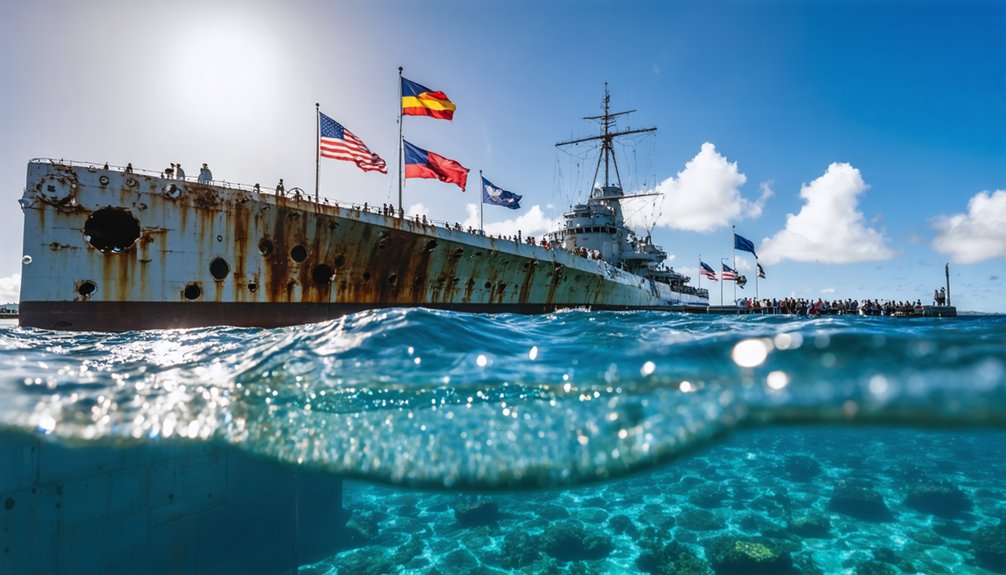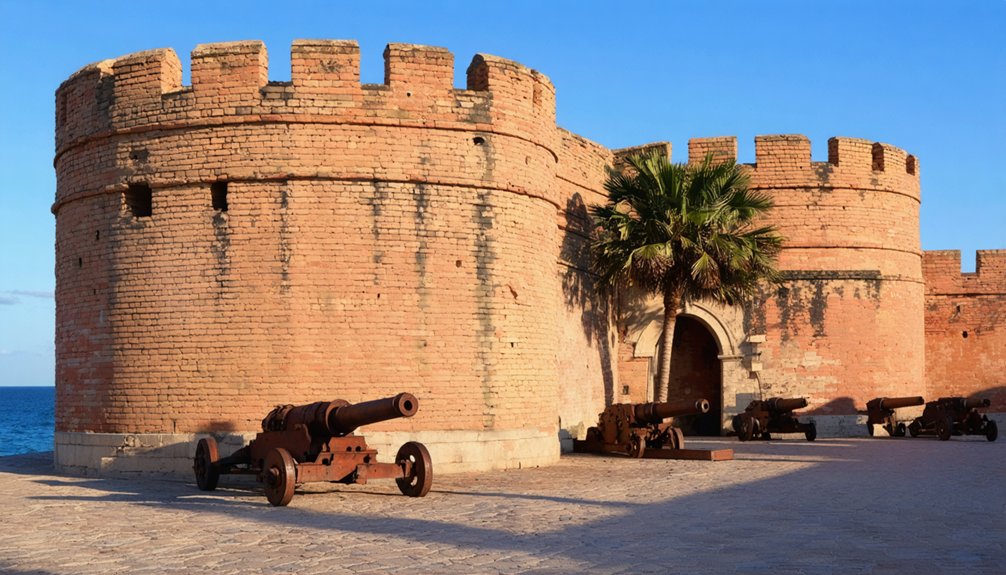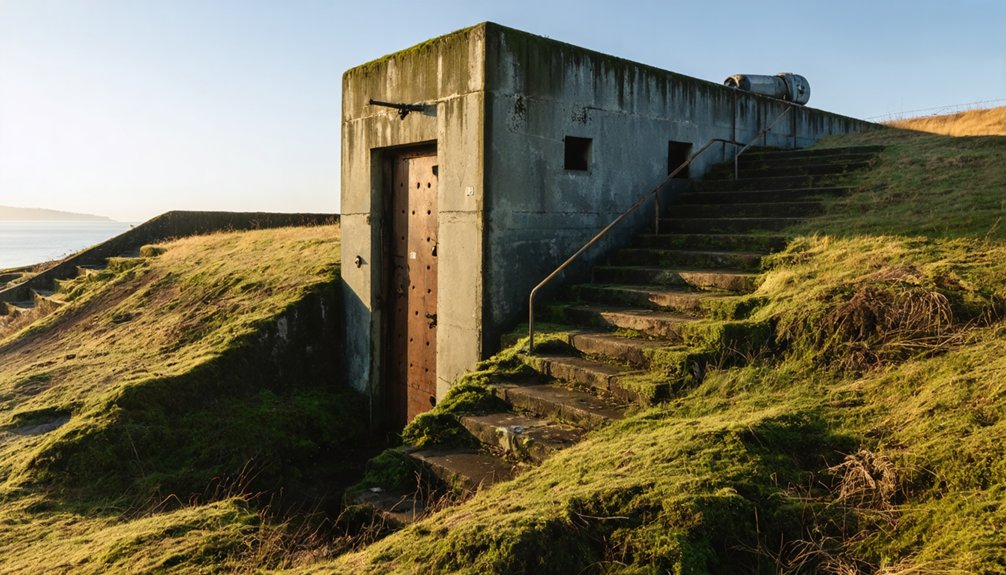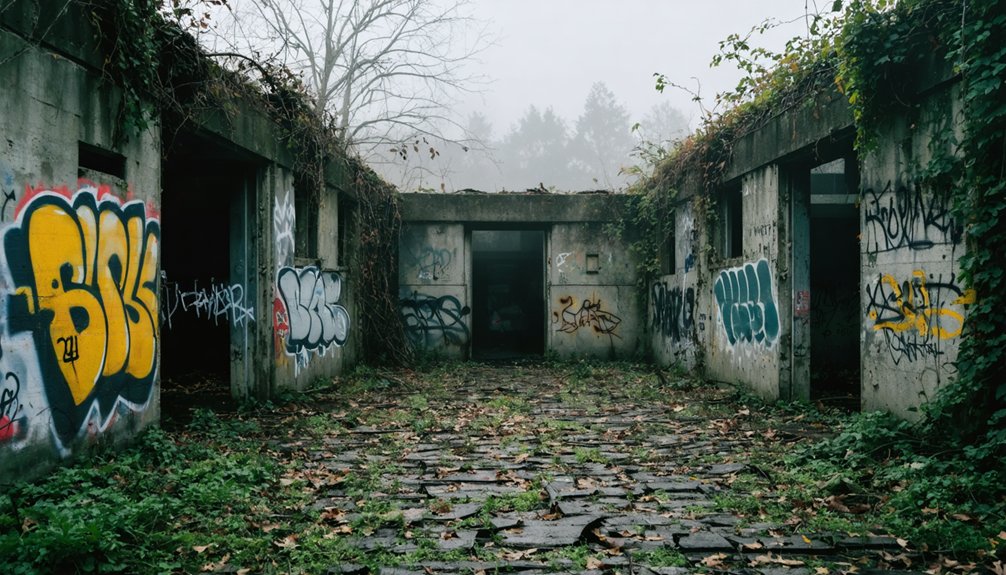Hereeniem a vezик
Key Takeaways
- Fort Jefferson in Florida stands as America’s largest brick masonry fortification, featuring 303 preserved casemates and historic Civil War-era prison cells.
- The Greenbrier Bunker remains an intact Cold War relic, complete with blast doors and decontamination chambers beneath the luxury resort.
- Fort Monroe’s rare moat system and original 1834 masonry construction showcase exceptional preservation of early American coastal defense architecture.
- West Point’s Revolutionary War fortifications from 1778 demonstrate continuous military presence and preserved tactical defense structures.
- Fort Morgan’s original 30-million-brick construction and Civil War-era artillery positions remain well-preserved along Alabama’s coastline.
Fort Jefferson: The Mighty Guardian of the Florida Keys
Standing as the largest brick masonry fortification in the Western Hemisphere, Fort Jefferson began its rise in December 1846 on Garden Key, Florida.
You’ll find this massive coastal defense structure constructed from over 16 million handmade bricks, featuring a sophisticated military architecture that included 303 vaulted casemates and a three-tier gun system designed to house 420 heavy weapons.
Known as the “American Gibraltar,” the six-sided fort’s strategic position helped control crucial maritime routes in the Gulf of Mexico.
During the Civil War, Union forces seized the fort in 1861, converting it into a prison that housed up to 1,700 personnel, including Dr. Samuel Mudd and other Lincoln assassination conspirators.
Though never attacked, the fort’s presence effectively deterred potential European strongholds until its abandonment in 1874. The fort later served as a Marine Hospital quarantine station in 1889.
Located approximately 70 miles west of Key West, this remarkable fortress continues to captivate visitors who brave the journey by boat or seaplane.
The Underground Marvel: Greenbrier Bunker’s Nuclear Legacy
You’ll find the most sophisticated congressional fallback position of the Cold War hidden beneath the luxurious Greenbrier Resort, where a massive 112,544-square-foot bunker was constructed to shield all 535 members of Congress from nuclear devastation.
Within its 720-foot-deep confines, the facility’s 25-ton blast doors protected state-of-the-art communications equipment, decontamination chambers, and enough provisions to sustain 1,000 people for 60 days during a nuclear crisis.
The bunker’s perfect marriage of five-star comfort and military-grade protection exemplified Cold War engineering excellence until its decommissioning in 1992, following a Washington Post exposé that ended its 30-year shroud of secrecy.
Staff members maintaining the facility were required to sign non-disclosure agreements to protect the bunker’s classified status and ensure its continued secrecy from the public.
During World War II, the Greenbrier served as the Ashford General Hospital where thousands of soldiers received medical treatment and rehabilitation between 1942 and 1946.
Secret Congressional Safe Haven
While the Cold War cast its shadow over America, a covert fortress lay hidden beneath the elegant Greenbrier Resort in White Sulphur Springs, West Virginia.
This nuclear shelter, constructed between 1958 and 1962, was designed to house all 535 members of Congress during a potential nuclear attack. A team of government maintenance staff, disguised as TV repair technicians, kept the facility operational for three decades. Codenamed “Project Greek Island,” the 112,000-square-foot complex sat 720 feet underground, protected by a 25-ton blast door. Local residents helped maintain the secret for decades, many unaware of its true purpose.
The congressional secrecy surrounding this facility remained intact for nearly three decades. You’d find enough supplies to sustain 1,100 people for weeks, including a 400-seat cafeteria, dual legislative chambers, and over 1,000 bunk beds.
Following its exposure in a 1992 Washington Post article, the government decommissioned the bunker in 1995.
Today, you can tour this remarkable Cold War relic at The Greenbrier Resort.
Cold War Engineering Feat
Deep beneath West Virginia’s rolling hills, the Greenbrier bunker stands as one of America’s most impressive Cold War engineering achievements. Built in 1962, this marvel of nuclear preparedness required 50,000 tons of concrete and descended 720 feet underground, masterfully disguised as a hotel expansion.
The Cold War architecture showcases unparalleled defensive capabilities, with a 25-ton blast door, lead-lined walls, and decontamination chambers protecting its occupants. A sophisticated 60-day food supply ensured Congress could maintain operations during extended nuclear emergencies. Today, the facility serves as both a data storage center while offering educational tours to the public.
You’ll find engineering precision in every detail: 1,300 telephone lines, independent power systems, and water purification facilities designed to sustain 1,100 people.
The bunker’s robust construction features reinforced steel throughout, buried under 20 feet of earth – a demonstration of American ingenuity during an era when freedom hung in the balance.
Luxury Meets Military Defense
Beneath the luxurious Greenbrier Resort‘s manicured lawns, America’s most sophisticated nuclear shelter merged five-star hospitality with military-grade protection.
This masterpiece of luxury warfare featured an ingenious contrast: while guests above enjoyed presidential-level amenities, a massive 112,544-square-foot bunker lay ready 720 feet below.
You’d never guess that behind the resort’s elegant façade, four blast doors weighing up to 28 tons protected a complete underground congressional compound.
This concealed preparedness facility included everything needed for 535 legislators to survive 30 days post-nuclear strike: dormitories, a 400-seat cafeteria, decontamination showers, and life support systems.
The facility maintained 1,300 telephone lines to guarantee continued governance while masquerading as a simple “West Virginia Wing” expansion to the public.
Dorothy Draper’s iconic interior design work above ground helped maintain the resort’s luxury facade during the bunker’s construction.
The bunker remained a closely guarded secret until The Washington Post exposed its existence in 1992, finally revealing one of the Cold War’s most remarkable installations.
Cheyenne Mountain: America’s Granite Fortress
Hidden within Colorado Springs’ southwestern border, the Cheyenne Mountain Complex stands as one of America’s most formidable military installations.
You’ll find this engineering marvel buried under 2,000 feet of solid granite, accessed through a one-third-mile tunnel that leads to blast doors weighing 25 tons each.
The Granite Fortress Security system incorporates three-story buildings mounted on giant springs within a 4.5-acre hollowed chamber, protecting against nuclear, EMP, and cyber threats.
Cheyenne Mountain Operations, initially designed to counter Soviet bombers, evolved from NORAD’s primary command center to today’s auxiliary nuclear command post.
While the facility’s modernization cost over $700 million between 2000-2006, it continues to serve as a critical missile warning center, operated 24/7 by the 21st Space Wing‘s joint service personnel.
Pearl Harbor’s Living Memorial at Joint Base Pearl Harbor-Hickam

While Cheyenne Mountain guards America’s heartland, Pearl Harbor stands as a solemn memorial to military valor on America’s Pacific frontier.
You’ll find over 3,000 historic buildings across this 28,000-acre installation, including the iconic USS Arizona Memorial where 1,177 brave sailors made the ultimate sacrifice on December 7, 1941.
The base’s Historic Preservation efforts protect both World War II artifacts and ancient Hawaiian cultural sites. You can explore the USS Bowfin submarine museum on Ford Island, featuring rare aircraft like an authentic 1942 Japanese Zero.
The base’s cultural resource management team works tirelessly with preservation partners to maintain these irreplaceable treasures while supporting an active military community of 84,000 personnel.
Every preserved building and artifact tells a story of sacrifice, ensuring future generations never forget Pearl Harbor’s legacy.
Fort Monroe: Cornerstone of Coastal Defense
You’ll discover Fort Monroe’s pivotal Civil War role as the only federal installation in the Upper South that remained under Union control throughout the conflict, serving as an essential staging area for military and naval operations.
The fort’s strategic position at Old Point Comfort made it an ideal headquarters for President Lincoln’s wartime visits and the 1862 Contraband Decision that earned it the nickname “Freedom’s Fortress.”
The original masonry construction, completed in 1834 with its rare moat feature, stands remarkably intact today, maintaining its architectural integrity as America’s largest stone-and-brick fortress.
Strategic Civil War Role
During the Civil War, Fort Monroe proved to be an invaluable Union stronghold as the only federal military installation in the Upper South that remained under Union control throughout the conflict.
You’ll find its strategic defenses were essential in preventing Confederate naval movements through Hampton Roads and the Chesapeake Bay, with powerful 42-pound cannons capable of striking targets over a mile away.
The fort’s position made it an ideal staging ground for Union military and naval operations, including the Peninsula Campaign and coastal blockades.
When you examine its impact on the war effort, you’ll see how it served as both a military bastion and a symbol of freedom.
Following the landmark Contraband Decision of 1861, the fort became a refuge for thousands of escaped slaves, fundamentally altering the course of the conflict.
Original Architecture Remains
Fort Monroe’s architectural grandeur stands as America’s most extensive masonry fortification, begun in 1819 under French military engineer Brigadier General Simon Bernard’s precise specifications.
You’ll find the original 25-foot-tall, 6-foot-thick walls stretching 1.3 miles around the hexagonal fort, enclosing 63 acres of strategic coastal defense infrastructure.
The fort’s historic preservation maintains exceptional architectural integrity, featuring seven distinct bastions and a rare tidal moat fed by Mill Creek.
You can explore the original casemates that served as both defensive positions and living quarters. The commanding officer’s residence, Quarters 1, exemplifies the fort’s military architectural heritage.
Walking the ramparts, you’ll follow the same path as generations of soldiers who’ve defended this cornerstone of American coastal defense, where granite walls sourced from Virginia and Maryland quarries still stand as proof to early 19th-century engineering prowess.
The Hidden Giant: Mickelsen Safeguard Complex

A colossal concrete pyramid rises from North Dakota’s plains, marking the location of America’s first post-World War II military installation – the Stanley R. Mickelsen Safeguard Complex. This Cold War architecture marvel stands 20 stories tall, embodying the Mickelsen legacy of innovative missile defense.
- The $6 billion fortress commanded up to 30 Spartan and 70 Sprint anti-ballistic missiles.
- You’ll find a nuclear blast-resistant structure housing the Missile Site Radar (MSR).
- The complex protected Minuteman missile fields at Grand Forks Air Force Base.
After achieving full operational status in October 1975, this technological titan served just six months before deactivation.
Today, while battling asbestos and groundwater issues, the complex draws Cold War enthusiasts and preservationists who recognize its vital role in America’s defensive capabilities during the arms race.
West Point: Where American Military History Lives On
As you walk West Point’s grounds today, you’ll find preserved Revolutionary War fortifications from 1778 standing alongside elegant 19th-century architecture like the 1820 Superintendent’s Quarters.
You’re treading the same training grounds where military innovators from Ulysses S. Grant to Norman Schwarzkopf developed their leadership skills across two centuries of American warfare.
The site’s continuous military occupation since the Revolutionary War has left an unbroken chain of military heritage, from the original iron Hudson River barrier to today’s modern military academy facilities.
Historic Architecture Endures Today
Standing as a symbol of America’s military heritage, West Point’s architectural legacy spans over two centuries through its distinctive Military Gothic style and beautifully preserved structures.
You’ll find historic preservation efforts that have maintained the fortress-like character while adapting to modern military education needs.
- The Old Cadet Chapel (1836) showcases Classic Revival elements, while the iconic Cadet Chapel (1910) dominates the hillside with militarized Gothic architecture.
- Fort Putnam’s restored stone ramparts and powder magazines reflect Revolutionary War engineering.
- Modern construction like Davis Barracks integrates historic stone masonry with 21st-century technology.
The campus’s National Historic Landmark status since 1960 protects this military architecture, from Georgian colonial officers’ quarters to the neo-classical West Point Officer’s Club, ensuring America’s military heritage endures for future generations.
Revolutionary War Training Grounds
From its origins as a strategic Continental Army stronghold in 1778, West Point’s Revolutionary War legacy endures through its preserved fortifications and historic grounds.
You’ll find Polish engineer Kościuszko’s military engineering masterpiece, including a 65-ton iron chain that blocked British naval advances up the Hudson River, preventing colonial division.
Fort Putnam’s stone ramparts still stand sentinel, housing original powder magazines and garrison quarters that showcase Revolutionary Warfare ingenuity.
Throughout the academy grounds, you’ll discover preserved artillery batteries and redoubts, evidence of 18th-century combat strategy.
These fortifications evolved into America’s premier military training center, established in 1802, where the grounds you walk once served as battlements protecting American independence.
Today, West Point remains the nation’s oldest continuously occupied military installation, bridging Revolutionary War heritage with modern military excellence.
Military Innovation Since 1802
When President Thomas Jefferson signed the Military Peace Establishment Act in 1802, he transformed West Point from a strategic fortress into America’s first military academy. The military evolution that followed shaped America’s warfighting capabilities through generations of innovation and tactical advancement.
- You’ll find preserved artillery pieces, munitions wagons, and limbers from battles like Saratoga and Yorktown in West Point’s museum, showcasing technological advancements in warfare.
- You can trace the academy’s engineering breakthroughs through its preserved fortifications and military construction innovations.
- You’ll witness how the curriculum evolved from basic engineering to include advanced sciences, tactics, and leadership training that’s produced commanders for every major American conflict.
West Point’s transformation from a modest two-story structure to the “New West Point” in 1902 reflects its enduring commitment to military excellence.
Fort Tilden’s Silent Sentinels: Coastal Artillery Batteries
The mighty Battery Harris stands as Fort Tilden’s most formidable coastal defense installation, featuring twin 16-inch guns that dominated the harbor’s protection from 1922 through World War II.
Battery Harris, with its massive twin 16-inch guns, guarded New York Harbor as Fort Tilden’s mightiest coastal defense from 1922-1945.
You’ll find these massive weapons encased in 10-foot-thick concrete casemates, covered by 20 feet of earth – a reflection of military technology advancement during wartime.
As you explore further, you’ll discover Battery Kessler‘s 6-inch guns, modernized in 1942, and the never-armed Battery 220, built in 1943.
The fort’s defensive network expanded with four Anti-Motor Torpedo Boat batteries and anti-aircraft guns strategically positioned at Norton and Rockaway Points.
These coastal artillery emplacements remain visible today, their concrete structures rising from the vegetation, serving as silent sentinels of America’s maritime defense heritage.
Fort Morgan: Defender of Mobile Bay

Thirty million locally manufactured bricks form the imposing star-shaped fortress of Fort Morgan, constructed between 1819 and 1834 on Alabama’s Mobile Point.
Skilled masons, including enslaved African Americans, built this strategic stronghold to replace the earlier Fort Bowyer, creating a formidable defense system that would prove essential during the Civil War.
- Fort Morgan’s construction features concentrated artillery positions, allowing defenders to rain devastating fire on approaching vessels.
- The fort’s Civil War significance peaked during the Battle of Mobile Bay, where Admiral Farragut’s famous “Damn the torpedoes” charge led to a two-week siege.
- Today’s preserved structure includes concrete batteries Schenck and Thomas, historic Battery Bowyer, and the original masonry walls that have withstood six military conflicts.
The site stands as a tribute to American military engineering and combat readiness across generations.
Fort Gorges: Portland’s Granite Island Stronghold
Standing sentinel on Hog Island Ledge, Fort Gorges emerged from Maine’s granite bedrock between 1858 and 1865 as a D-shaped fortress protecting Portland Harbor‘s strategic waters.
Modeled after Fort Sumter, this Civil War-era stronghold joined Fort Scammel and Fort Preble to form a triangulated defense system against potential Confederate raiders.
Three coastal fortresses stood guard over Portland Harbor, a strategic triangle of defense against Civil War threats.
Despite its architectural significance and robust construction, Fort Gorges never fired a shot in anger.
By its completion, advances in military technology had already rendered its defenses obsolete.
You’ll find the fort’s later role shifted to storing mines and munitions during both World Wars.
Today, you can explore this raw piece of history by boat, walking the same granite corridors where soldiers never stood guard, experiencing a unique snapshot of 19th-century military engineering preserved in time.
Frequently Asked Questions
How Many Military Base Relics Are Still Used for Active Training?
You’ll find dozens of historic military bases conducting active training facilities nationwide, where troops execute military training exercises in preserved World War II-era forts, coastal defenses, and Revolutionary-period installations.
What Security Measures Restrict Public Access to Preserved Military Installations?
You’ll face strict access control with ID checks, visitor passes, background screening, security protocols, surveillance systems, and restricted movement zones. Military police monitor entry points and patrol preserved installation perimeters continuously.
Which Military Relics Are Most Threatened by Climate Change?
Perilous predicaments plague your coastal forts like Pulaski and Monroe, where rising temperatures and coastal erosion threaten their foundations. Arctic installations face permafrost collapse, while western outposts battle wildfires.
How Much Does It Cost Annually to Maintain These Historic Bases?
You’ll find annual maintenance costs range from $500,000 to $5.6 million per base, with funding sources including federal budgets, preservation grants, private donations, and revenue-generating partnerships with commercial tenants.
Are There Volunteer Programs for Helping Preserve Military Base Relics?
You can join volunteer opportunities at military heritage sites and active bases, supporting preservation efforts through tours, conservation projects, restoration work, and historical documentation alongside professional staff members.
References
- https://www.loveexploring.com/gallerylist/233478/americas-eeriest-abandoned-military-sites
- https://www.amc.af.mil/Portals/12/documents/AFD-131018-055.pdf
- https://thewanderclub.com/blogs/blog/best-military-bases-in-the-us-for-scenery
- https://www.legendsofamerica.com/notable-and-historic-us-military-bases/
- https://greatergood.com/blogs/news/cs-advanced-military-bases
- https://www.popularmechanics.com/technology/design/g152/strangest-military-bases-gallery/
- https://www.sandboxx.us/blog/best-military-bases-in-the-us/
- https://www.denix.osd.mil/legacy/denix-files/sites/33/2021/12/The-Military-Heritage-Guidebook-Guide-Legacy-03-196.pdf
- https://simpleflying.com/5-most-remote-us-military-air-bases-strategic-roles/
- https://en.wikipedia.org/wiki/List_of_American_military_installations



